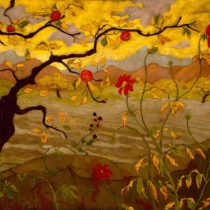 1864 - 1909
nabis, post-impressionism
1864 - 1909
nabis, post-impressionism
Description Paul-Elie Ranson
Paul-Élie Ranson, born in 1864 in Limoges, France, emerged as a pioneering figure in the avant-garde art movement, playing a pivotal role in the development of the Nabis group. His artistic journey unfolded against the backdrop of fin de siècle Paris, marked by a fervor for experimentation and a quest for new forms of expression.
Ranson's early training in law gave way to his true passion for art, leading him to the Académie Julian and the École des Beaux-Arts in Paris. His encounters with fellow artists, including Paul Sérusier and Maurice Denis, laid the foundation for the formation of the Nabis—a collective of artists who sought to break free from traditional artistic constraints.
The Nabis, inspired by the principles of Symbolism and influenced by the Japanese woodblock prints, embraced a diverse range of mediums and techniques. Ranson's contributions to this movement were significant, and his distinctive style combined elements of mysticism, decorative arts, and a vibrant use of color.
One of Ranson's notable works is the decorative panel "Les Sorcières" (The Witches), which exemplifies his fascination with symbolism and allegory. This piece, like many others, showcased his interest in exploring the spiritual and mystical dimensions of art.
Ranson's versatility extended beyond painting. He ventured into printmaking, illustrating books, and even designed furniture and textiles. His commitment to integrating art into various facets of daily life reflected the Nabis' ethos of art as a holistic, immersive experience.
The artist's personal life was intertwined with his artistic pursuits. His marriage to Marie-France, a talented artist herself, further solidified the creative milieu in which Ranson thrived. Their home, decorated with their own works and those of their artistic circle, became a hub for avant-garde discussions and collaborations.
As the 20th century dawned, Ranson's interests expanded to include involvement in the decorative arts movement, notably contributing to the establishment of the Académie Ranson. This institution aimed to integrate fine arts, decorative arts, and crafts into a unified curriculum, reflecting Ranson's belief in the interconnectedness of artistic disciplines.
Paul-Élie Ranson's life and artistic contributions were cut short when he succumbed to illness in 1909 at the age of 44. Despite his relatively brief career, Ranson's impact endured. His legacy as a founding member of the Nabis and a proponent of art as a holistic experience continues to influence subsequent generations of artists exploring the intersections of symbolism, spirituality, and the decorative arts.

No Comments Yet...